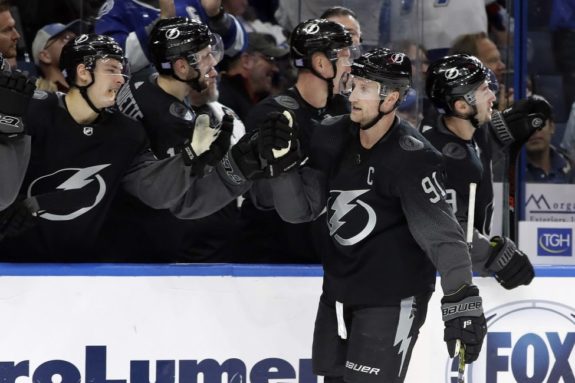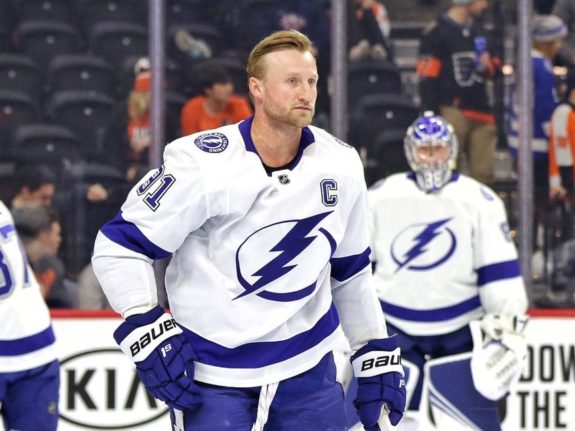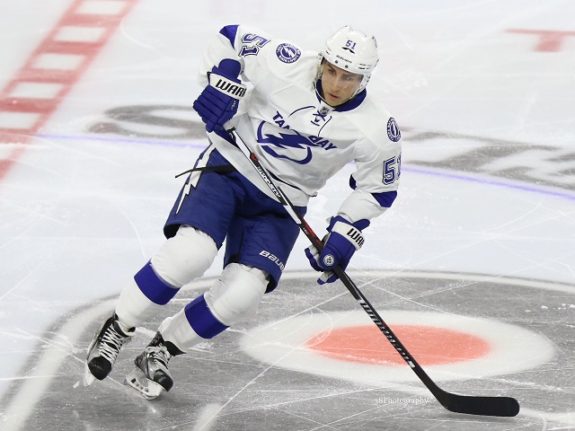Throughout their early history, the Tampa Bay Lightning found success as an offensively driven team. Even when their defense and goaltending struggled with consistency, the Lightning could put enough points on the board to, at the least, keep games close.
The 2010s were no different, as the Lightning assembled one of the most prolific scoring cores in the NHL. From top to bottom, their forwards produced at incredible rates, oftentimes finding themselves at or near the scoring race at the end of each season.

Now, with the decade coming to a close, what would a starting forward lineup look like for a Lightning all-decade team?
Top Line: St. Louis-Stamkos-Kucherov
First off is the Lightning’s top line, which would feature Steven Stamkos at center along with Martin St. Louis and Nikita Kucherov on the wings. The reason why these players are the top line is simple: these players produced at a prolific rate while playing in Tampa Bay.
To start off, Stamkos scored 60 goals in 2011-12, a feat that he alone accomplished this decade. He would go on to play 616 games throughout the 2010s, registering 332 goals and 655 points, all team highs.

While his time with the Lightning ended abruptly in 2014, St. Louis still had one of his best seasons in his 14-year career with the franchise in 2012. At the ripe old age of 37, he won the Art Ross, scoring 60 points in 48 games. He would also register 294 points in 269 games this decade, putting him sixth in overall scoring this decade for Tampa Bay.
Finally on the top line is Kucherov, who had two 100-point seasons and registered the most points in Lightning history when he scored 128 points in 2018-19. This brought the Art Ross back to Tampa Bay while showcasing that Tampa Bay’s Russian winger was a true superstar in the league. He also posted close to 200 goals and 500 points, good for second in scoring on the team this decade.
Second Line: Palat-Johnson-Point
On Tampa Bay’s second line of their all-decade team is Ondrej Palat, Tyler Johnson and Brayden Point. These three players helped define the DNA of the Lightning this decade by overcoming all odds in their path to the NHL.
First, we will talk about Palat and Johnson together, as their careers were heavily intertwined this decade. Both players joined the Lightning in the 2011 offseason as longshots to make the NHL and started playing with then-Amerian Hockey League affiliate, the Norfolk Admirals. This squad in Norfolk was a truly special one, as they would rattle off a 28-game winning streak, which set a professional hockey record en route to the 2012 Calder Cup.
After a successful AHL venture, both Palat and Johnson would start their NHL careers in 2013-14, where they were thrust into the spotlight after an injury to Stamkos. They excelled in this role, eventually leading to both players being nominated for the 2014 Calder Trophy for rookie of the year.

Over the course of the decade, Palat and Johnson would see incredible success in Tampa Bay, with both players scoring 100-plus goals and 300-plus points in the regular season. They also contributed heavily in the playoffs, helping to lead the team to the 2015 Stanley Cup Final and two additional Eastern Conference Finals.
The final member of the second line is Point, who fought his way onto the Lightning’s opening-night roster in 2016 after being a third-round selection at the 2014 NHL draft. He would go on to be one of the team’s most dynamic forwards, scoring 41 goals and 92 points in 2018-19 alone, while earning an All-Star nod in 2018.
Also, despite only playing in three-full seasons in Tampa Bay, he sits seventh in scoring for the decade, a testament to just how productive he has been and continues to be.
Third Line: Killorn-Filppula-Purcell
The Lightning’s third line combines three players who made a noticeable impact on the ice for the franchise throughout the decade.
First is Alex Killorn, a player who may not be a dominant scorer, but is someone who was one of the Lightning’s most consistent players this decade. Since he started his career in 2012-13, he has played in 548, good for second behind only Stamkos. He also has a massive plus-63, which is fourth overall for the team.
At center on the third line is Valtteri Filppula, who played three seasons in Tampa Bay before being traded at the 2017 trade deadline. When he joined the franchise, Filppula represented a needed veteran presence who contributed both on the ice and in the locker room.

Filppula’s play settled down Tampa Bay’s top-six forwards and helped to bring a winning culture to the Lightning’s locker room. While he wasn’t always perfect, he was a major factor in Tampa Bay becoming a true contender throughout the decade.
The final member of the third line is Teddy Purcell. Throughout the start of the decade, Purcell was a key member of the Lightning’s top-six, scoring 64 goals and 194 points, putting him eight overall in the decade. While his play was never dominant, he was an important factor that helped Tampa Bay make the 2011 Eastern Conference Final.
Fourth Line: Malone-Lecavalier-Callahan
The Lightning’s fourth line features a handful of players who received big extensions but ultimately left the team before the final contracts ended officially. While all of these players represented the future at one point or another, they were unable to live up to the massive contracts they signed.
First is Vincent Lecavalier, one of the truly great Lightning players of all time. While his final years with the franchise at the start of the decade were far from his best, he still represented the face of hockey in Tampa Bay. The fact that his number was retired in Feb. 2018 showcases just what he meant to the team.

Next is Ryan Malone, whom the Lightning signed to a massive seven-year deal in June 2008. While he produced well in his first two seasons with the franchise, Malone’s scoring started to slow throughout the 2010-11 season. By the time that he hit final year of his contract, Tampa Bay decided to buy him out due to his struggles both on and off the ice.
Finally is Ryan Callahan, one of the true ‘heart and soul’ players for the Lightning this decade. While his production never lived up to the six-year, $34.8 million contract he signed in 2014, he still provided important leadership to a young team as they broke into national relevance. If not for a degenerative back disease, he may have finished his contract with Tampa Bay, but he was forced to retire from hockey in the 2019 offseason.
Lightning Forwards Corps Was Incredible in the 2010s
While the Lightning needed to rebuild their goaltending and defense throughout the 2010s, their forward corps remained the strongest part of the franchise. With two Art Ross winners, a Rocket Richard winner, and numerous players breaking 20-30 goals each season, scoring was one thing the franchise didn’t lack this decade.
Related: Lightning’s All-Decade Team: Defense
With so many great forwards in their core right now, the Lightning look set to dominate scoring again throughout the 2020s. In fact, if things play out as planned, a number of the players listed above could find themselves on the list of the best forwards of the decade when we reach that point in 10 years.